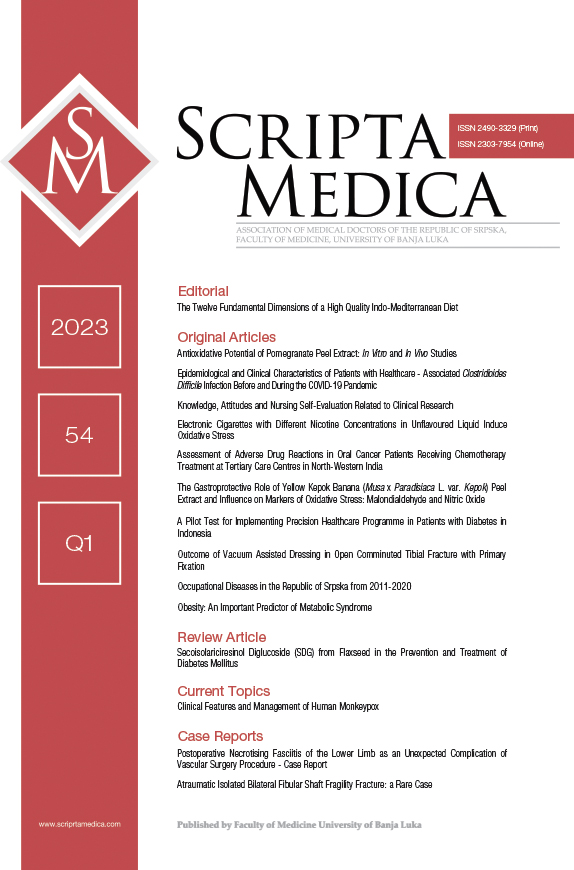Outcome of Vacuum Assisted Dressing in Open Comminuted Tibial Fracture with Primary Fixation
Outcome of Vacuum Assisted Dressing in Open Comminuted Tibial Fracture with Primary Fixation
Abstract
Background/Aim: Wound management of the compound open tibia (Gustilo-Anderson grade 2, 3a, 3b) is complicated by a higher infection and the problem of adequate soft tissue coverage is significant. Primary wound closure is not easily advisable in these types of compound open tibial fractures. Early tissue flap or graft procedure might increase the complication rate due to temporary graft rejection and wound infections. The aim of this study was to analyse the duration required for formation of healthy granulation tissue, duration required for making wound fit for skin cover procedure and duration of hospital stay in compound open tibia fracture treated with vacuum assisted closure (VAC).
Methods: A prospective interventional study of 22 patients aged 18 to 60 years was done. After assessing the size of the wound, primary bone fixation and wound debridement were carried out as soon as possible and then VAC was applied. Assessment of VAC therapy was based on mean decreases in wound size and “modified Johner and Wruh's criteria”, used for assessment of the functional outcome of tibial shaft fracture was recorded during each follow-up.
Results: Twenty two patients suffered comminuted open fractures of tibia-fibula. Primary fixation of bone were done with vacuum dressing. During follow-up, the good decrease in wound size considering vacuum dressing remedy was once 18.75 ± 18.36 cm2 (p = 0.001). Six patients achieved excellent results according to “modified Johner and Wruh's criteria” of tibial shaft fracture.
Conclusion: This technique effectively reduced wound size, accelerated the formation of healthy granulation tissue of wound with open fracture bone and provided a better functional outcome. The VAC treatment had suggestively increased wound closure rate, decreased morbidity and costs for patients.
References
1. Budoš MM, Veselý MR. Possibility to influence treatment of open tibial fracture by negative pressure wound therapy. IJST 2019 Nov 14;1(1):10-41.
2. Schirò GR, Sessa S, Piccioli A, Maccauro G. Primary amputation vs limb salvage in mangled extremity: a systematic review of the current scoring system. BMC Musculoskelet Disord 2015 Dec 2;16:372. doi: 10.1186/s12891-015-0832-7.
3. Cross WW 3rd, Swiontkowski MF. Treatment principles in the management of open fractures. Indian J Orthop 2008 Oct;42(4):377-86.
4. Ma Z, Li Z, Shou K, Jian C, Li P, Niu Y, et al. Negative pressure wound therapy: Regulating blood flow perfusion and microvessel maturation through microvascular pericytes. Int J Mol Med 2017 Nov;40(5):1415-25.
5. Setty A, Mehta K, Jenkins P, Linderman S, Kamaraju SY, Thota VA. M-VAC-Portable Negative Pressure Wound Therapy (NPWT) for low resource settings. JACS 2021 Nov 1;233(5):e161. doi:10.1016/j.jamcollsurg.2021.08.434.
6. Hasan MY, Teo R, Nather A. Negative-pressure wound therapy for management of diabetic foot wounds: a review of the mechanism of action, clinical applications and recent developments. Diabet Foot Ankle 2015 Jul 1;6:27618. doi: 10.3402/dfa.v6.27618.
7. Payton E, Khubchandani J, Thompson A, Price JH. Parents' expectations of high schools in firearm violence prevention. J Community Health 2017 Dec;42(6):1118-26.
8. Ploumis A, Mpourazanis G, Martzivanou C, Mpourazanis P, Theodorou A. The role of vacuum assisted closure in patients with pressure ulcer and spinal cord injury: a systematic review. World J Plast Surg 2019 Sep;8(3):279-84.
9. Cozza V, Pepe G, Cintoni M, De Maio F, Tropeano G, Magalini S, et al. Vacuum-assisted closure (VAC®) systems and microbiological isolation of infected wounds. World J Emerg Surg 2018 Nov 20;13:53. doi: 10.1186/s13017-018-0216-z.
10. Yadav S, Rawal G, Baxi M. Vacuum assisted closure technique: a short review. Pan Afr Med J 2017 Nov 21;28:246. doi: 10.11604/pamj.2017.28.246.9606.
11. Gustilo RB, Anderson JT. Prevention of infection in the treatment of one thousand and twenty-five open fractures of long bones: retrospective and prospective analyses. J Bone Joint Surg Am 1976;58:453–8.
12. Johner R, Wruhs O. Classification of tibial shaft fractures and correlation with results after rigid internal fixation. Clin Orthop Relat Res 1983 Sep;(178):7-25.
13. Wang W, Pan Z, Hu X, Li Z, Zhao Y, Yu AX. Vacuum-assisted closure increases ICAM-1, MIF, VEGF and collagen I expression in wound therapy. Exp Ther Med 2014 May;7(5):1221-6.
14. Sinha K, Chauhan VD, Maheshwari R, Chauhan N, Rajan M, Agrawal A. Vacuum assisted closure therapy versus standard wound therapy for open musculoskeletal injuries. Adv Orthop 2013;2013:245940. doi: 10.1155/2013/245940.
15. Atiç R, Alemdar C, Azboy İ, Bulut M, Çaçan MA, Gem M. Application of vac in type III open fractures. J Clin Anal Med 2018;9(6):498-503.
16. Rasool G, Ahmed MU, Iqbal M, Khwaja Z. Vacuum assisted wound closure and normal saline dressing in treatment of Gustilo type II, type IIIa and IIIb open fracture of tibia. RMJ 2013;38(4):382-4.
17. 15. Suman H, Krishna J, Sharma Y, Jain P, Parmar S. Role of VAC dressing in the large open fracture: a single center prospective study from Indore. Int J Res Rev 2021;8(4):22-5.
18. Stannard JP, Volgas DA, Stewart R, McGwin G Jr, Alonso JE. Negative pressure wound therapy after severe open fractures: a prospective randomized study. J Orthop Trauma 2009 Sep;23(8):552-7.
- Authors retain copyright and grant the journal right of first publication with the work simultaneously licensed under a Creative Commons Attribution License that allows others to share the work with an acknowledgement of the work's authorship and initial publication in this journal.
- Authors are able to enter into separate, additional contractual arrangements for the non-exclusive distribution of the journal's published version of the work (e.g., post it to an institutional repository or publish it in a book), with an acknowledgement of its initial publication in this journal.
- Authors are permitted and encouraged to post their work online (e.g., in institutional repositories or on their website) prior to and during the submission process, as it can lead to productive exchanges, as well as earlier and greater citation of published work (See The Effect of Open Access).

